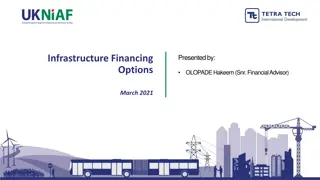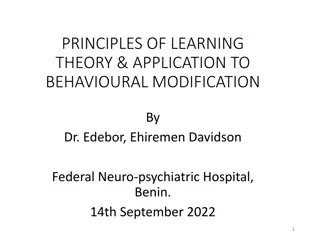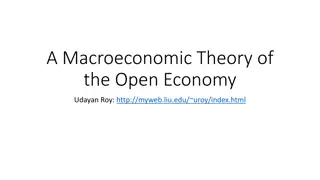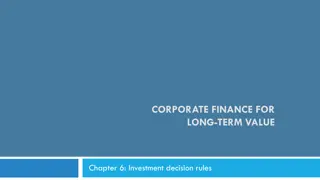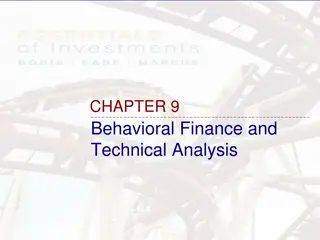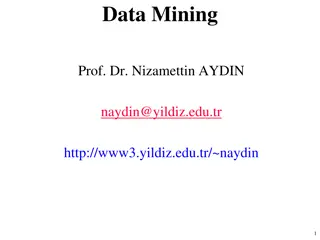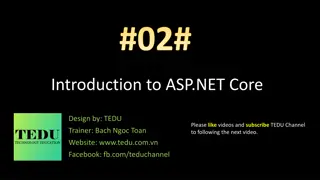Understanding Behavioral Finance: Core Concepts and Anomalies in Investment Theory
Study the economic theory of the human mind applied to behavioral finance, covering core ideas of standard investment theory, empirical anomalies, and major patterns in asset markets. Explore concepts such as excess volatility, long-term reversal, and short-term momentum in investment decisions.
Uploaded on Sep 30, 2024 | 0 Views
Download Presentation

Please find below an Image/Link to download the presentation.
The content on the website is provided AS IS for your information and personal use only. It may not be sold, licensed, or shared on other websites without obtaining consent from the author. Download presentation by click this link. If you encounter any issues during the download, it is possible that the publisher has removed the file from their server.
E N D
Presentation Transcript
Content Introduction Intuition from languages Brief history of entropy theory and its extension to investment theory Main results of behavioral finance
Math preparation: logarithm functions Theory of information Theory of learning and psychology Theory of judgement: Its value and bias Investor judgement and trading decisions Major patterns in asset markets
Introduction We will study an economic theory of human mind and its application to behavioral finance. In this introduction we will overview the following topics 1. Core ideas of the standard investment theory 2. Empirical anomalies 3. Established alternative explanations and their problems 4. A brief content of behavioral finance
Some core ideas of the standard investment theory Share value is the discounted sum of future dividends Market is efficient. New information is instantly reflected in the change of share prices. Expected returns can be calculated from capital asset pricing models.
Empirical anomalies Excess volatility: Robert Shiller: "Do Stock Prices Move Too Much to be Justified by Subsequent Changes in Dividends?", American Economic Review (June 1981), 71(3): 421 436. Shiller s wife is a psychologist. So he is very attracted to behavioral theory. He got Nobel Prize in economics in 2013 for empirical analysis of asset prices.
Long term reversal: Werner F. M. De Bondt and Richard Thaler, 1985, Does the Stock Market Overreact? Journal of Finance, Vol 40, 793- 805, The paper is an extension from De Bondt s Ph.D, dissertation. Implication to investment Richard Thaler got Nobel prize in 2017 for his work on behavioral economics. He played a role in the movie The Big Short.
Short term momentum: Jegadeesh, Narasimhan and Sheridan Titman, 1993, Returns to buying winners and selling losers: Implications for stock market efficiency, Journal of Finance 48, 65-91. Implication to investment and valuation on investment skill
Equity premium puzzle: Mehra, R. and Prescott, E. 1985, The Equity Premium: A puzzle? Journal of Monetary Economics, 22, 133-136. Implication to investment: Heavy on stocks. Equity premium is even higher after the publication of this paper. Why?
Multifactor models: Fama, Eugene F.; French, Kenneth R. (1993). "Common Risk Factors in the Returns on Stocks and Bonds". Journal of Financial Economics 33 (1): 3 56.. Implication to investment. Invest in small and value stocks. Success stories: Goldman Sachs Global Investment Strategy. Clifford S. Asness, Applied Quantitative Research http://www.aqr.com/ You can find many research papers on its website.
Trading volume and subsequent returns. Lee, Charles and Bhaskaran Swamminathan, 2000, Price momentum and trading volume, Journal of Finance 55, 2017-2069. From the standard theory, volume doesn t play a role. Implication to investment: For long term, invest in low volume stocks. For short term, hot stocks.
Size of trading and returns: Hvidkjaer, Soeren, 2006, A trade-based analysis of momentum, Review of Financial Studies 19, no. 2, 457 491. Large traders perform better than small traders. Implication to investment. Follow the large traders. But better be quick.
Detailed analysis of trading records of individual investors. Odean, Terrance, 1999, Do Investors Trade Too Much, American Economic Review 89, 1279-1298. No brokerage firms were willing to share trading data. Odean was very persistent. In the end, he got some trading data. Many later papers analyze the same data set. Odean: A very special life and career trajectory. He was once a monk. Actual investment performances: Better known: Warren Buffet, less known: Ed Thorp, and many more. And many more.
Possible project and essay topic Compile some anomalies in investment
Established alternative theoretical models Utilize various psychological models to explain away empirical patterns. But they are quite ad hoc and could not explain broad range of patterns. For example, most behavioral models are silent about volume of trading. Barberis, Nicholas, Andrei Shleifer, and Robert Vishny, 1998, A model of investor sentiment, Journal of Financial Economics 49, 307-345. Daniel, Kent, David Hirshleifer and Avanidhar Subrahmanyam, 1998, Investment psychology and Security market under and overreactions, Journal of Finance 53, 1839 1885. Hong, Harrison and Jeremy Stein, 1999, A unified theory of underreaction, momentum trading and overreaction in asset markets, Journal of Finance 54, 2143-2184.
Intuition from languages Languages are a window to human mind. Patterns of languages often reveal how our minds process information. In languages, not all words are of the same length. In general, more frequently used words are shorter than less frequently used words. For instance, in the sentence, I climb a mountain. the word I has only one letter and the word mountain has eight letters. This pattern develops because I is used much more frequently than mountain .
Words get shortened as their usage becomes more common. Thus, taxi and cab came from taxicab, and cab in turn came from cabriolet. (Pierce, 1980, p. 246) Automobile becomes car; bicycle becomes bike; television set becomes television and then simply TV; personal computer becomes PC; software becomes app; gasoline becomes gas.
By representing high probability events with shorter expressions, we reduce the time and effort in information transmission. Therefore, language is not a purely random mapping from the concrete worlds to the abstract symbols. It is a highly structured coding system that reduces the average length of messages. Language systems are economic systems.
Statistics, languages and human psychology We always read about Bill Gates, Jeff Bezos and more recently, Elon Musk. The world must be full of billionaires. We rarely read about average Joe. There must be very few average people out there. However, if you do a simple statistics, it is easy to find out that the opposite is true. The outstanding are the few who stand out from the crowd. The average is indeed quite average. The mean is indeed quite mean. The median is indeed quite mediocre.
However, you wont tell an average Joe he is mean or mediocre. Otherwise, he will be really mean to you. We are all very biased. But many kinds of biases have evolutionary advantages. This is why they evolve and why they won t go away.
Mean and meaning The meaning of something is really the mean. The average is the most representative.
Illusion and dis-illusion Why we all have illusion? Why truth is so hard to accept? It is because we don t want to hear truth. Truth is dis-illusion. We don t want to get disillusioned.
Lax and relax We want relax. We don t like lax. But one can t re-lax before lax.
Rejuvenate and juvenile We always want to rejuvenate economy. But our society doesn t have many juveniles. We can t rejuvenate our economy without many juveniles.
Strive and strife We want to strive. We don t want to get strife. But to strive will cause a lot of strife, to others and to yourself.
Inspire and expire Inspire is to breathe in. Expire is to breathe out. We like to inspire. We don t like to expire. But we can t inspire without expire.
Vent, pre-vent and prevent Vent is to vent your opinion. Pre-vent is to facilitate others vent their opinions early so as not to accumulate too much grievance. Prevent is the opposite of pre-vent. This suggests the evolution of actions.
Information processing as an economic behavior First, mental processes are physical processes and entail physical costs. Ideas occur at a blink of eye, which gives us impression that thinking is effortless. This seeming effortless, however, is achieved with high maintenance cost of the brain. Metabolically the brain is a very expensive organ. Representing only two percent of body mass, the brain uses about twenty percent of energy in humans.
Neurons have to be continuously charged to maintain high energy level so it can transmit information quickly. On cellular level, neural cells and muscle cells function very similarly. The process of transmit information with neural cells and the process of transmit force with muscle cells are very similarly physiologically. We all know that muscle movements take energy. Similarly, mental processes are physically processes that require physical costs, a lot of physical costs.
Second, since mental activities are so costly, it is of great evolutionary advantage to develop ways to lower the cost of information processing. There are many ways to reduce the cost of information processing. One way is to process only small amount of information selectively. Light has a very broad spectrum. But our eyes can only detect a very narrow spectrum of visible lights, with wavelength from 380 nm to 750 nm. This narrow band of visible lights corresponds to the part of solar lights with maximum strength. Our eyes have greater chance to see things clearly.
Proteins are constructed from twenty kinds of amino acids. But our tongue can detect only one of them, glutamine. Glutamine, which our taste buds can sense, happen to be the most important one among the twenty types of amino acids. Glutamine is the most important amino acid in biochemical processes. Bacteria synthesize glutamine first and build all other amino acids from glutamine.
We dont have sense organs to detect electric fields, while some fish do. Our genes related to the sense of smell are highly degenerated. This suggests our ancestors could smell much better than we do. Dogs smell is much more sensitive than human s. Since it is costly to develop and maintain information processing capacity, only the most frequently occurring events that are highly relevant to our survival will be detected by our senses and processed by our mind.
Information collection and its importance From what information we collect, we can often assess its importance. Our tongue can taste glutamine but not other amino acids. We can infer that glutamine is the most important amino acid. Our sense of smell is greatly degenerated. This indicates that the function of smell is less important to the survival of us than the survival of our ancestors. We walk straight up. This increases the importance of vision and decreases the relative importance of smell.
We will pursue certain information and neglect others. We also spend different amounts of effort to obtain different kinds of information. There are about five times more sensors of coldness than sensors of hotness under our skin. This is because humans have less capacity to adjust to coldness than to adjust to hotness. Detecting coldness is especially important to us for our survival.
Although our fingers are much smaller than our back, the area in brain responsible for information processing from fingers is much larger than the area in brain responsible for information processing from our backs.
Different living organisms occupy different ecological niches. What is important for one species may not be important to other species. As a result, different living systems may process different types of information in different ways. Similarly, different people occupy different ecological and social niches. What is important for one person may not be important to other people. As a result, different people may process different types of information in different ways.
Brief history of entropy and information James Maxwell (1831-1879) was a Scottish mathematician and scientist. In 1871, James Maxwell, in a thought experiment, linked the cost and value of information processing to entropy.
For the first time, cost of information and value of information got connected. It is through entropy. From here, we can see that entropy is the universal measure of value and cost. It also indicates that the most fundamental purpose of information is to gather resource, or low entropy.
James Maxwell was one of the three founders of statistical mechanics. The other two were Ludwig Boltzmann (1844-1906) and Willard Gibbs (1839-1903). Boltzmann defined entropy as ? = ????? Here W is the number of states a system possesses.
This connect entropy to the probability space. The second law of thermodynamics, or entropy law, states that the entropy of a system tends to increase toward the its maximum. With Boltzmann s definition, a physical system tends to move toward its maximal probable state.
Gibbs defined entropy as ? = ????? = ??( ???( ?????)) This is identical to Shannon s later definition of information, except a constant.
In 1948, Shannon defined information mathematically by the entropy function. He defined the function of information from mathematical deduction. He was probably unaware of entropy from physics. He proved that the entropy function represents the minimal cost of information transmission. In other words, the entropy theory of information is an economic theory of information.
Shannons theory became very popular. Many people attempted to apply his theory to broader contexts. In 1956, John Kelly applied Shannon s theory to investment. This links investment to information. Later, we will show that Kelly s theory can be extended to where investors don t have complete information. This is behavioral finance.
First, information is costly. The value and cost of information are highly correlated. From James Maxwell (1871), if the physical cost of obtaining information is less than the reduction of entropy in a physical system, then the second law of thermodynamics is violated. Because he was confident the second law of thermodynamics is universal, the cost of obtaining information must be higher than the reduction of entropy in a physical system. In other words, the cost of information must be higher than the value of information.
If this is true, why we even bother to obtain information? This is because we mostly concentrate on some patterns in nature last for a long time and hence the same information can be used again and again. We ignore the part of information that don t repeat very often. So the total value of certain information may be higher than the cost of obtaining the information.
For example, the sun is hotter than the earth and probably will be for billions of years. As a result, the average frequency of light emitted from the sun is much higher than the average frequency of light emitted from the earth. In other words, the earth receives low entropy light from the sun and emits high entropy light toward space. The earliest organisms that successfully utilized this information with photosynthesis could use it again and again and replicate its genes to pass the information to their descendants.
Information has positive value only when there is a persistent pattern related to that particular information. If some information has positive net value, the carrier of that information will grow until other constraints reduce the net value of that information to zero.
For example, since the earliest organisms developed the ability to absorb solar energy, their offspring spread all over the world to fill most places on the earth, until the constraints of available land and nutrients prevented their further expansion. At this time, the net value of photosynthesis of each plant approaches zero, or the cost of information on photosynthesis is close to the value of information on photosynthesis.
We try to recognize and remember patterns that can be used again and again. We tend to ignore most of the information that don t repeat very often. As a result, we can be accused of bias. But everyone can only process part of the information. When one accuse others of being biased, he merely regards his own bias as the standard.







